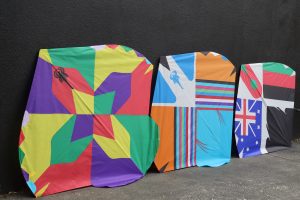Refugee flying a kite for his future
Kite flying has always been a part of Mohammad Balkhi’s life.
As a child he would run through the streets of Kabul with his friends sending brightly coloured, home-made kites aloft into Afghanistan’s azure skies.
 At age 12, Mohammad started making his own kites as the traditional Afghan custom of kite flying took hold and became a passion.
At age 12, Mohammad started making his own kites as the traditional Afghan custom of kite flying took hold and became a passion.
Now resettled in Melbourne as a refugee, he hopes to turn his passion into a business.
“I grew up in central Kabul where kite making and flying was a thing that was very common. In Afghanistan, we did it for fun but now I would like to create a business out of making and selling kites,” Mohammad said.
Mohammad worked at a range of jobs in Afghanistan, most recently in a printing and copying shop.
But after the fall of Kabul, Mohammad and his family were forced into hiding.
“My father worked as a guard at the Australian embassy in Kabul, so his association with a foreign government made him a potential target of the Taliban,” Mohammad said.
“We were forced to lay low and, for a year, we were in hiding. We couldn’t risk being identified by the Taliban. At the same time, we were trying to get passports, so we could leave,” he said.
After securing passports, Mohammad and his family spent ten weeks in Iran waiting for visas to come to Australia. Mohammad’s father’s connection with the Australian embassy made the visas possible.
Mohammad, his wife and two children, as well as his parents arrived in Australia two years ago and settled in Dandenong, in Melbourne’s south-east.
He says they are grateful to have found safety in Australia and he sees a bright future for his two children, aged three and five months.
But Mohammad suffers from a herniated disc in his back and is unable to do physical work or even sit for long periods.
“Making and selling kites is way for me to work and earn a living,” Mohammad said.
He has already sold kites at local festivals and among the Afghan community in Melbourne’s south-east.
“I lived among a strong culture of kite making when I was young and I want to preserve the culture here in Australia,” Mohammad said.
His kites are made from thin paper connected by a thin string to a hand made spool. Unlike western kites which are held static against the wind, Afghan kits are designed to be run with.
“We get someone to hold the spool and then we throw the kite up in the air. The wind coupled with special movements of the string makes for a lovely view of dancing kites in the sky.” Mohammad said.
Mohammad glues together coloured pieces of paper to form intricate and colourful designs, making the kites decorative items as well as flying machines.
 They are held together by thin pieces of treated wood from Afghanistan. The kites range in size from 20cm square up to a metre square.
They are held together by thin pieces of treated wood from Afghanistan. The kites range in size from 20cm square up to a metre square.
Kite flying is one of Afghanistan’s national outdoor sports and Afghans have been flying kites for more than a century.
Kite flying is also considered to be an art form with a plethora of designs, colours and sizes.
For many, the hobby has become a matter of honour with competition to be the best kite flyers in their neighbourhoods.
Kite flying in Afghanistan was banned by the Taliban during the 1996 – 2001 war. It was against the law for several years, but after the collapse of the Taliban government, it has become legal again.
Many young Afghans are attracted to the sport and the best season for kite flying in Afghanistan is during autumn because of the favourable winds.
The most common place to fly kites in Kabul is in Chaman-e-Babrak, a park in the north of the city, where many kite-flying competitions are held.
Kids, teenagers, adults, and older people come from all around Afghanistan and to participate in these competitions.
In Afghanistan’s cities, the sky is filled during these competitions with hundreds of brightly coloured kites soaring high into the air going from one side to the other.
Khaled Hosseini, the author of The Kite Runner, a novel that explores life under the Taliban as well as kite flying, writes about the sport of kite fighting.
“When an opponent’s kite is cut free, it flutters like a colourful, dying bird into the far reaches of the city,” Hosseini wrote.
To find out more about Mohammad’s kites or how you can purchase them for flight or decorative purposes, contact Mohammad on 0476 279 444.












